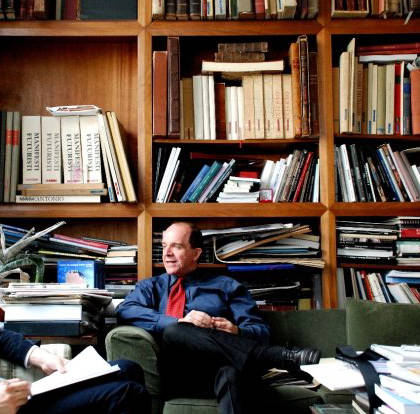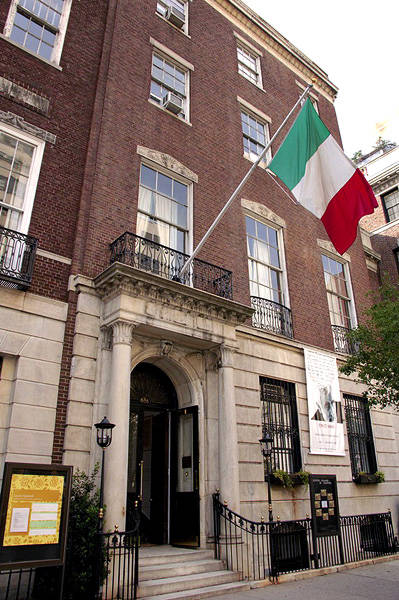New York. Energy at the Italian Cultural Institute
We interviewed the director of the Italian Cultural Institute, art critic, and Italian historian Renato Miracco.
Since his early days in office, he has worked to create a new image for that monument to Italian culture in New York, the Italian Cultural Institute. He has done so with creativity and enthusiasm, but also with a realistic approach. He has transformed the headquarters on Park Avenue into an increasingly more vibrant venue for concerts, presentations, exhibits, as well as a meeting place for artists and writers, and for the young and the young at heart.
Firm and tenacious, with support as well as some opposition, he has, over the course of one and a half years, transformed the image of the Italian Cultural Institute while consistently bringing the institution to the attention of the media and the American people.
We remind him, when we begin our discussion, of the very first interview that we did, when he had just arrived....
A year and a half? It seems like 10 years! It’s difficult to sum up the emotions and the experiences that have accumulated during this time...”
He immediately reaches back into his memory, to the days when he first arrived.
I photographed the institute just as I entered the building. I actually photographed it so that I could remember it just as I found it. One of my priorities has been to open up the rooms and make them more accessible, to recover the dignity that had been completely lost, the dignity of the building both on the inside and the outside. I started by adding lamps and flowers, and painting the railings and the walls. I wasn’t able to do all that I would have wanted because I didn’t have financial resources. But, if nothing else, we can now count on at least three areas for exhibits, presentations, and meetings which allow us to rotate spaces.
The last space is a small gallery that will be renovated with funds donated by Giulia Ghirardi Borghese. The space will accommodate events dedicated to photography, that is, artists and photographers. We will almost definitely inaugurate the opening with an exhibit by Tina Modotti in September....
Tina Modotti? The Italian-American who is so significant yet not at all well-known….
Exactly, this is exactly one of my goals, to introduce personalities such as this. The second objective is to create a different perception of the Italian Cultural Institute. It must be seen as a dynamic place where things happen, sometimes even glamorous events. It can’t be seen as a stale place, but one that provides a space for young people. This can be done while remaining faithful to tradition.
I remember the two times that we went to events at the Armory Show. It’s not easy with all the competition. American guidebooks now consider the Italian Cultural Institute among the trendiest places, along with the Metropolitan. It’s not just because we sponsor the “Sunday at the Met” events. When there is an Italian conference at the Met on Sunday, the institute is always present. It’s fantastic! The presence of so many diverse people is fantastic – and not just Italians, who are of course always welcome. Italian culture is becoming more well-known but not only in a self-referential way among Italians. Italian culture needs to be promoted to Americans, and that is why we speak both English and Italian at the institute’s events. It’s for this reason that the New York Times has practically monitored our progress over the years and has dedicated many truly flattering articles to our events.
The Morandi exhibit at the Met was certainly a magical moment for Italian culture in New York.
The exhibit that I curated for the Metropolitan, along with Maria Cristina Bandiera, was a great opportunity. At that time I had also organized a concurrent exhibit at the institute of watercolors and drawings that then toured the U.S. It was event organized in partnership with major American cultural associations.
And to raise the visibility of your events, you created a series of books….
Yes, it was a series published by the Cultural Institute. For now, there is only one section on art, but there will, of course, be a section on literature. The first volume was devoted to Melotti, the second was devoted to Morandi, the third to young artists in New York, and the fourth to Torre. These are the cornerstones of an extensive plan.
Miracco’s strategy is clear: collaboration and synergy, particularly with New York and American cultural stakeholders.
It is important to present Italian contemporary art in partnership with American institutions. It is not a point of arrival, but a point of departure. But to reach this point, the institute needs to develop a sense of integrity that was not there before.
It is essential, in my opinion, to get one’s hands dirty. For example, to organize an event involving young people, you need to get close to young people. To do this you must go and see, look, and do it directly without delegating. And that goes for everything. You can’t talk about culture if you don’t live it every day, if you don’t go to the right places every day. This is as true for art as it is for literature. Consider the Pen Festival, for example. It was the first time the institute hosted a Pen event.
You have overcome many difficulties. Which ones are still left?
The difficulties that remain, I think, are like those of a woman in labor. They are there at first and then they are forgotten once they have been overcome; they are replaced by the joy of having overcome them. The fatigue is forgotten…. There are only a few of us; I would really like to hire more people….
Would you like more autonomy?
Yes, I have some autonomy, but then many times it depends on other conditions. It’s very difficult to have direct contact with our benefactors. If they have money, they prefer to organize an event on their own, not to associate themselves, not to give money to an institution. The Italian mentality, a little less so in the U.S., is that the state must provide, not the private sector.
How do you choose events?
The quality is of course crucial. The first thing is to move away from self-referential events, and we have succeeded in part. The second is to organize events that interest a greater percentage of the American and the Italian public, and doing so in such a way that people feel at ease at the institute, part of the life of the institute. I have a serious problem with programming. We are in a country where things need to be planned three or four years in advance, not 10 or 15 days. The budget that I have barely covers the building’s maintenance. And we can’t forget – how can I guarantee programming in three or four years, if first of all, I don’t know if I can stay for two or three or four more years....
I’d like to return to planning important events. I’m thinking about Futurism.
How can I do this? And how can I do it without any money? At this point I don’t know how much money I have this year for Futurism, but I will do it nevertheless. It’s the first time that the institute is involved with Yale, Briston, CUNY, Columbia University, the MoMa, the Metropolitan, and others. We will all work together to create a program about Futurism.... We are all equally prestigious organizations; we’ll host events and we’ll go there for conferences.
I know that you are preparing for a major fundraising campaign...
Yes, fundraising, that’s true, but without a silent auction. People must be willing to show their faces if they really want to help. This, for me, is fundamental, especially if we consider hosting the event at a glamorous locale rather than have a seated dinner. I don’t want to waste money, either on the location or on food. You eat at home, but you can go there for a drink and most importantly to support Italian culture. I would therefore like to do something a little different, something less conventional and a little more challenging.
And when were you thinking of having it? Where?
In mid- to late September. I can say that Fabrizio Ferri will willingly donate his “Industrie” space where Madonna had her party. And I’m also trying to involve Italian actors and actresses....
So we can say that Futurism will be a great celebration in the coming months....
And that’s not all. We also have the science festival with Vittorio Bo to mark Gallileo’s anniversary. There will be a series of lectures here at the institute, and perhaps at Hunter College and at CUNY. I am organizing it along with the region of Venice.
It’s all about synergy, contacts, and collaboration….
Otherwise, we can’t do it…not at all….
Concert of the group "Dissonanzen". The event was held recently at the Italian Cultural Institute. It is the first of a series organized by Renato Miracco to celebrate Italian Futurism.
Translated by Giulia Prestia













































i-Italy
Facebook
Google+
This work may not be reproduced, in whole or in part, without prior written permission.
Questo lavoro non può essere riprodotto, in tutto o in parte, senza permesso scritto.